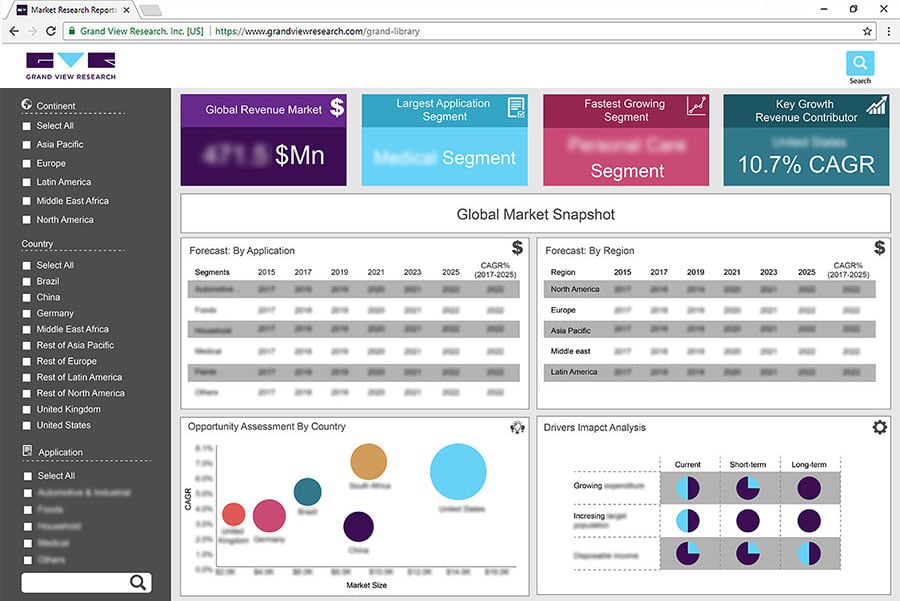- Home
- »
- Animal Health
- »
-
Veterinary Endotracheal Tubes Market Size Report, 2030GVR Report cover
![Veterinary Endotracheal Tubes Market Size, Share & Trends Report]()
Veterinary Endotracheal Tubes Market Size, Share & Trends Analysis Report By Animal Type (Dog, Cat, Others), By Product Type (Cuffed, Uncuffed), By End-use (Hospitals, Clinics), By Region, And Segment Forecasts, 2023 - 2030
- Report ID: GVR-4-68040-152-7
- Number of Report Pages: 150
- Format: PDF, Horizon Databook
- Historical Range: 2018 - 2021
- Forecast Period: 2023 - 2030
- Industry: Healthcare
Market Size & Trends
The global veterinary endotracheal tubes market size was estimated at USD 8.29 million in 2022 and is estimated to expand at a compound annual growth rate (CAGR) of 8.3% from 2023 to 2030. Key drivers contributing to this growth include rising hospitalization & surgical procedures coupled with pet insurance adoption, rising pet expenditure, and critical care visits. The pet population has increased significantly over the past few years due to the increasing number of households that want to adopt a pet for a better quality of life. For instance, some factors mentioned by the Global Animal Health Association in 2022 are increased level of physical activity, which occurs due to pet accompaniment, sustained mental health benefits through pet companionship, exposure to germs that can ideally alter the gut of the pet owner and, in turn, offer good health.
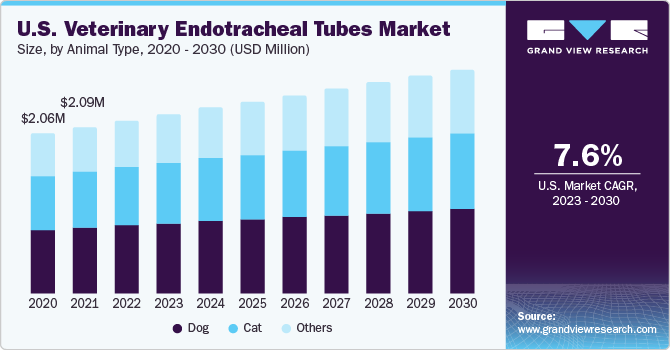
The American Heart Association stated that dog ownership has some role in minimizing cardiovascular disease risk. The increasing pet population is increasing the need for the market as pets may have emergencies such as accidents and other causes for surgeries requiring an endotracheal tube.
The COVID-19 pandemic, as well as the macroeconomic headwinds of 2022, notably impacted the market. This included supply chain challenges, operational hurdles, rise of input costs, and increased awareness for disease prevention. Most of the veterinary surgeries were delayed or postponed due to the COVID-19 pandemic, which disrupted the market growth to a certain extent. Most of the veterinary services and manufacturing sites were shut down; hence, the market faced a negative impact. However, post-COVID-19, there was a high demand for various pet surgeries and treatments as most households adopted a pet during COVID-19, and the high demand elevated the market growth post-COVID-19.
The rising number of veterinary surgeries and critical care visits is driving the use of endotracheal tubes to perform surgeries by providing animal support to breathe. For instance, in 2022, as per the Animal Medical Center in the U.S., 4,064 surgeries have been performed on animals, and around 19,399 animals visited the emergency and critical care division, which also may require surgeries.
End-use Insights
In terms of end-use, the hospitals segment held the dominant market share of 61.45% in 2022. The segment growth is driven by the increasing number of pet owners relying upon hospitals for treating their pets, as hospitals provide a wide array of healthcare services. Some of the veterinary hospitals have a 24/7 emergency and critical care division, which is elevating the need for veterinary endotracheal tubes as most of the pets visiting the emergency and critical care division would require either surgery or other treatments with general anesthesia and hence it is expected to fuel the segment growth.
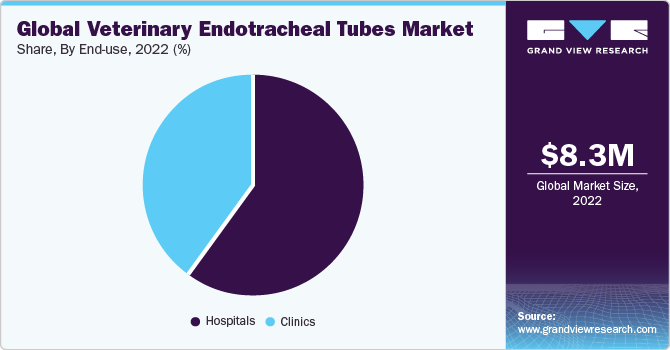
On the other hand, the clinics segment is anticipated to register the fastest CAGR of 8.76% over the forecast period. The segment growth is attributed to the increasing number of clinics globally. Clinics are also undertaking various stages to function like a hospital and provide services to pets and animals. Some clinics provide services such as critical care units and surgery rooms for pets by improving their infrastructure; hence, such factors are elevating the growth of the clinic's segment during the forecast period.
Animal Type Insights
Based on animal type, the dog segment dominated the market in 2022 with a revenue share of 41%. While the cat segment is projected to grow at the fastest CAGR of about 8.25% over the forecast period. The global dog population is growing, leading to rising demand for getting them checked and tested. The pet owners constantly get their pets tested and checked. In some cases, the pets have to undergo surgeries due to a disease or an accident, and such instances demand endotracheal tubes, which can help the veterinarian perform surgeries that require general anesthesia. Hence, such factors are elevating the growth of the segment.
As per the Global Animal Health Association, in the United States, there are approximately 85 million dogs. It further states that families in the U.S., Europe, and China are owners of around half a billion cats and dogs. As of 2021, 70% of households in the U.S. owned a pet, compared to 68% in 2016. Thus, the significant global pet population is elevating the growth of the market.
Regional Insights
In terms of region, North America dominated the market with a revenue share of more than 31% in 2022. This is owing to factors such as the presence of leading market players, increasing pet population, and elevating expenditure towards pets. Key companies, including Medtronic, Conduct Science, and Harvard Apparatus, have a presence in the U.S. In addition, according to the American Veterinary Medical Association (AVMA), pet owners' spending on their dogs and cats increased between 2020 & 2022, and the mean annual expenditure toward veterinary visits for dogs increased from USD 224 in 2020 to USD 362 in 2022. Hence, such factors are elevating the market growth within the region.
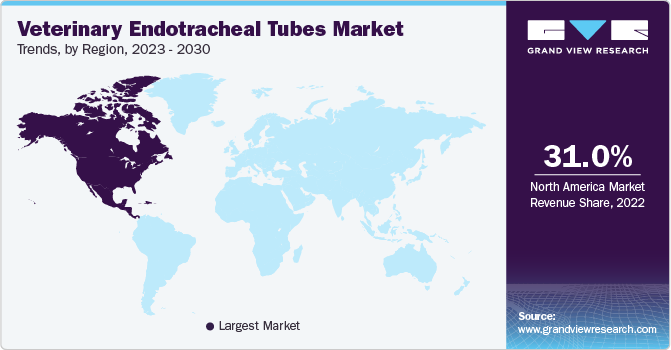
Asia Pacific region is anticipated to register the fastest CAGR of over 8% over the forecast period due to the high pet population, increasing number of local market players, and increasing awareness of animal health. The region also comprises many veterinary hospitals and clinics that carry out various surgeries on animals, and hence, this would elevate the need for veterinary endotracheal tubes.
Product Type Insights
Based on product type, the cuffed type segment is attributed with the largest market share of over 66.0% in 2022. This is due to greater product penetration, especially in emergency and critical care surgeries. A cuffed endotracheal tube provides certain advantages, such as increasing the fractional inspired oxygen percentage, enabling positive pressure ventilation, firmly securing the airway, and the risk of tracheal damage in minimum.
On the other hand, the uncuffed segment is estimated to grow at the fastest CAGR of 8.8% during the forecast period. This growth is driven by increasing product penetration as companies provide options for uncuffed endotracheal tubes.
Key Companies & Market Share Insights
Several prominent companies, including Medtronic, Conduct Science, Harvard Apparatus, RWD Life Science Co., LTD, and Vetamac, Inc., compete for market share globally. These companies have established themselves as key competitors through their extensive product portfolios, strong distribution networks, and advanced research & development capabilities. Market players additionally engage in strategic partnerships, acquisitions, and collaborations to strengthen their industry position and improve their product offerings. These partnerships enable companies to utilize each other's strengths, access new markets, and enhance their product offerings.
Key Veterinary Endotracheal Tubes Companies:
- Medtronic
- Conduct Science
- Harvard Apparatus
- RWD Life Science Co., LTD
- Vetamac, Inc.
Veterinary Endotracheal Tubes Market Report Scope
Report Attribute
Details
The market size value in 2023
USD 8.8 million
The revenue forecast in 2030
USD 15.4 million
Growth rate
CAGR of 8.3% from 2023 to 2030
Base year for estimation
2022
Historical data
2018 - 2021
Forecast period
2023 - 2030
Quantitative units
Revenue in USD million & CAGR from 2023 to 2030
Report coverage
Revenue forecast, company ranking, competitive landscape, growth factors, and trends
Segments covered
Animal type, product type, end-use, region
Regions covered
North America; Europe; Asia Pacific; Latin America; MEA
Country Scope
U.S.; Canada; UK; Germany; Italy; France; Spain; Netherlands; Japan; China; India; South Korea; Australia; Brazil; Mexico; Argentina; South Africa
Key companies profiled
Medtronic; Conduct Science; Harvard Apparatus; RWD Life Science Co., LTD; Vetamac, Inc.
Customization scope
Free report customization (equivalent up to 8 analysts’ working days) with purchase. Addition or alteration to country, regional & segment scope.
Pricing and purchase options
Avail customized purchase options to meet your exact research needs. Explore purchase options
Global Veterinary Endotracheal Tubes Market Report Segmentation
This report forecasts revenue growth at the regional & country level and provides an analysis of the latest trends and opportunities in each of the sub-segments from 2018 to 2030. For this report, Grand View Research has segmented the global veterinary endotracheal tubes market report based on animal type, product type, end-use, and region:
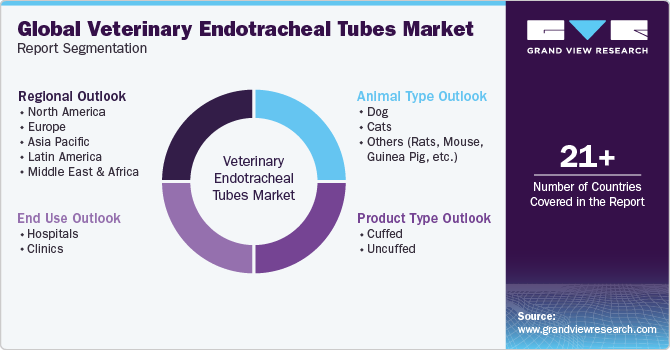
-
Animal Type Outlook (Revenue, USD Million, 2018 - 2030)
-
Dog
-
Cats
-
Others (Rats, Mouse, Guinea Pig, etc.)
-
-
Product Type Outlook (Revenue, USD Million, 2018 - 2030)
-
Cuffed
-
Uncuffed
-
-
End-use Outlook (Revenue, USD Million, 2018 - 2030)
-
Hospitals
-
Clinics
-
-
Regional Outlook (Revenue, USD Million, 2018 - 2030)
-
North America
-
U.S.
-
Canada
-
-
Europe
-
UK
-
Germany
-
France
-
Italy
-
Spain
-
Netherlands
-
Rest of Europe
-
-
Asia Pacific
-
Japan
-
China
-
India
-
South Korea
-
Australia
-
Rest of Asia Pacific
-
-
Latin America
-
Brazil
-
Mexico
-
Argentina
-
Rest of Latin America
-
-
Middle East & Africa
-
South Africa
-
Rest of MEA
-
-
Frequently Asked Questions About This Report
b. The global veterinary endotracheal tubes market size was estimated at USD 8.29 million in 2022 and is expected to reach USD 8.8 million in 2024.
b. The global veterinary endotracheal tubes market is expected to grow at a compound annual growth rate of 8.37% from 2024 to 2030 to reach USD 15.4 million by 2030.
b. Cuffed type product attributed to the highest market share of over 66.0% in 2022. This is due to greater product penetration especially in emergency and critical care surgeries.
b. Several prominent companies, including Medtronic, Conduct Science, Harvard Apparatus, RWD Life Science Co., LTD, and Vetamac, Inc., compete for market share in the veterinary endotracheal tubes market
b. Key drivers contributing to this growth include rising hospitalization & surgical procedures coupled with pet insurance adoption, rising pet expenditure, and critical care visit. The pet population has increased significantly over the past few years due to the increasing number of households that want to adopt a pet for a better quality of life.
Share this report with your colleague or friend.
![gvr icn]()
NEED A CUSTOM REPORT?
We can customize every report - free of charge - including purchasing stand-alone sections or country-level reports, as well as offer affordable discounts for start-ups & universities. Contact us now
![Certified Icon]()
We are GDPR and CCPA compliant! Your transaction & personal information is safe and secure. For more details, please read our privacy policy.
We are committed towards customer satisfaction, and quality service.
"The quality of research they have done for us has been excellent."





